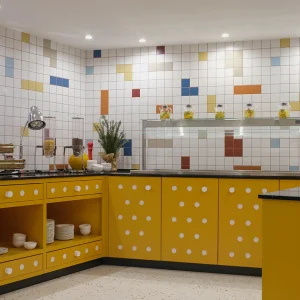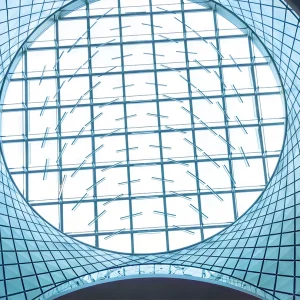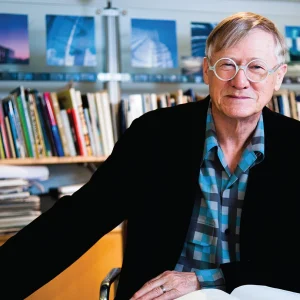
Some of the most important caves adorned by Bronze Age petroglyphs at Lascaux in France are naturally illuminated at the solstices which, added to the long-held theory that the images have some spiritual significance, suggests that light, ritual and belief have a very deeprooted association. In the Judaeo-Christian tradition, God not only called natural light into being in the Book of Genesis (‘And God said, let there be light, and there was light’) but, in Exodus, revealed the design of the seven-lamped menorah to Moses.
And yet, after all this time, places of worship still present lighting designers with problems, some of them architectural in origin, others to do with how the buildings are used, and yet more centring on conservation, technology and cost. High ceilings, obstructions such as pillars and banners, and even reflected glare from silverware all present the lighting designer with challenges that are examined in guidelines being readied for publication by the Society of Light and Lighting. Lighting Guide 13 (LG13), Places of Worship is thought to be the first guidance of its kind and covers buildings ranging in scale from cathedrals and temples to multifaith chapels at airports.
In the UK, the stock of churches and congregations is rising even though the actual number of churchgoers has been falling for a century. Manchester University’s Mark Littler reckons there are now 50,700 churches or congregations in the UK; Jewish, Muslim and Sikh places of worship number in the hundreds but are increasing in number. LG13’s author, Hilclare lighting applications manager David Holmes, says the interior lighting’s main purpose in places of worship is to enable participants to see what they are doing and what is happening around them. Visual comfort and safety are also important. To that extent, churches are similar to the workplace and much of the advice in the guide is based on new thinking on issues such as lighting the horizontal plane and regulations covering emergency lighting.
On a functional level, they share characteristics with auditoria: churches are usually oriented west to east, creating a visual hierarchy and directing the congregation’s view towards the sanctuary, altar and East window, much like a conventional theatre’s audience is directed to the proscenium. ‘You light towards the east to minimise direct glare and use roof members to conceal the lighting behind corbels and arches as you look in that direction,’ says lighting designer James Morse, responsible for the award-winning scheme for Salisbury Cathedral. ‘Clergymen often complain about glare when they face the congregation but it’s more important for parishioners to see them.’
Church lighting is ‘staged’ at different levels: low in the nave and rising at the altar to ensure that attention is drawn there during services. Historically, this has been achieved with natural light and candles. The guide points out that ‘often the more successful daylighting designs are those that offer a combination of daylighting strategies. Low-rise buildings offer the greatest opportunity to realise a controlled daylit environment because the designs can, in principle, accommodate various daylighting features and devices. In addition, low-rise building designs can also feature skylights, clerestory windows, light wells, over-hangs, deep self-shading reveals and so on.’
Lighting designer Michael Grubb says that in the UK and overseas church architects and lighting designers ‘celebrate daylight much more these days. It always used to be about artificial light and the building itself, but now it’s back to where it began’. Nowhere more so than at the Cathedral of the Northern Lights by Schmidt Hammer Lassen architects and Link Arkitektur in Arctic Norway.
It has a spiral belfry clad in reflective titanium to catch the Northern Lights, but inside, during the white nights and days of summer, light enters through tall, slim, irregularly placed windows and a skylight illuminates the whole wall behind the altar.
In new buildings it is sometimes possible to control daylight using blinds and other devices, but lighting designers increasingly turn to lighting controls to moderate lighting levels, manipulate space and accommodate activities beyond the traditional service such as concerts, and visitors.
‘You have different services at different times of the year, from funerals to midnight mass, that need different lighting,’ remarks Grubb. ‘And the problem with very grand buildings such as cathedrals is that they are so spectacular inside that you can lose the sense of intimacy that worship calls for. So you have to have a series of settings that include low-lighting levels and create tranquil spaces’.
Morse advises that controls can be used to ‘make a room within a room. You can have a setting where it is very intimate, where the rest of the lighting is off or low and just have some accent lighting on the altar, the reredos and the East window to give a very atmospheric effect, especially for a small service or choral evensong’.
Light for reading music or text by is a vital ingredient in most places of worship. ‘You have to light the choir area from both sides to reduce shadowing, or it may be necessary to give the whole area a medium level of light from on high and have individual luminaires on the choir stall,’ says Holmes.
Churches often want lighting that is directed down on to the page, says Morse, ‘but this is tricky so they will use task lighting to prevent the problem. For example, at Salisbury Cathedral there are LED strips on the choir stalls’. Reducing contrast between the task area and surrounding areas is necessary for any form of task lighting. However, a common technical problem is that traditional church furniture is dark and absorbs light while ‘choristers using sheet music are looking at music on a white background. You can’t over-egg it or the sheet luminance will be too great’ he adds.
As LG13 points out, ‘Most churches, and many synagogues and mosques, are large areas which are difficult to heat… and benefit greatly by being illuminated with a "warm" light source having a colour temperature of 2700K or 3000K. In addition, when the designer wants to highlight a particular area or action, the use of light sources with different colour temperatures for the task area and surrounding areas can be very beneficial and economical.’
Panasonic recently relamped almost the whole of Prague Castle, including St Vitus Cathedral, using LED lamps as a direct replacement for the existing incandescent lighting. Some 19,000 lamps were replaced in all, using four types that included Panasonic’s retro-looking Nostalgia Clear range, which directly mimics an old-fashioned and inefficient but warm light filament bulb. While it may not improve the original lighting concept, this type of retrofit upgrade has the advantage of preserving the atmosphere of a heritage site without the need for new wiring or fittings, and thus saves energy. ‘For the first time ever we have light sources that are very efficient and are also dimmable and have great longevity,’ says Morse. ‘This has only happened in the past three years.’
Admir Jukanovic of lighting consultant Mindseye also believes LEDs offer a big advantage. ‘With new technology we’ll probably see more integration and the possibility to be more true to the space by not placing disproportionately big luminaires in places they shouldn’t be. With LEDs you don’t have to think of the size of the fitting, or how to get mains voltage electricity up there. They give more freedom to bring light where you want it – where you need it to be rather than simply where it can be.’
German lighting designer Lunalicht’s all-LED scheme for St Stephan Church in Karlsruhe won the Lamp Lighting Solutions Awards 2013. The church’s dome contains a 6m-diameter oculus, which is surrounded by a hidden light ring containing 1,920 warm white (2700K) LED modules that light the church from a height of 26m. More hidden lighting illuminates the dome, the vaulted ceiling and walls.
Four types of optic and careful angling of the luminaires ensure that lighting is even on all these surfaces. There is independent lighting of the central areas, aisles, walls and altar island, with general lighting at 80 lux and the altar lit at 300 lux, all under DALI lighting control.
Facing a challenge that is far from atypical, Cundall Light4 relit the chapel at Mossley Hill Church in Liverpool with a brief to deliver a variety of lighting scenes for prayer meetings, readings, group discussions, sewing and stitching banners. The Church had lit the space using cheap outdoor flood and spotlights and the altar had been illuminated by 100W incandescent lamps. Light4 used LEDs throughout to reduce the energy load, from 690W to 310W with all the lights on and to just 220W using typical scenes.
Adjustable LED spotlighting, positioned at high level, provides the functional lighting. Narrow beams direct the light at the altar, with additional fittings directing light into the centre of the space. LED pendants provide additional light in the prayer room, providing an extra layer of light for reading. Meanwhile, the central altar mural is illuminated with integrated linear LEDs, improving the colour contrast of the mural artwork and creating a warm glow from within the altar.
‘The most important aspect of the design was to create a synergy between the lighting and architecture. We wanted to create a succession of layered light that started at the entrance threshold and moved through into the chapel. The concept design for the glass sphere pendants was to emphasise the symmetry of the architecture, while adding a delicate modern twist to the Grade II* building,’ says Light4 director Andrew Bissell.
For some people, places of worship are also places of work, but unlike the office or factory it is hard to judge how lighting design affects productivity – except, perhaps, in the case of the chaplain at Harrow School who remarked that having lighting controls in the pulpit – part of a scheme by DPA Lighting Consultants – was a splendid opportunity to engage the congregation’s attention by flicking a switch and declaring ‘let there be light’.





